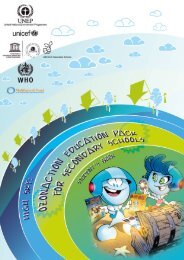Chapter 2. Progress towards the EFA goals - Unesco
Chapter 2. Progress towards the EFA goals - Unesco
Chapter 2. Progress towards the EFA goals - Unesco
You also want an ePaper? Increase the reach of your titles
YUMPU automatically turns print PDFs into web optimized ePapers that Google loves.
PROGRESS TOWARDS THE <strong>EFA</strong> GOALS<br />
Early childhood care and education<br />
formative years, children develop <strong>the</strong> cognitive and<br />
wider skills that will prepare <strong>the</strong>m for school. Pupils<br />
from disadvantaged backgrounds often enter school<br />
carrying a legacy of disadvantage in many areas,<br />
including lower levels of communication, language<br />
and literacy skills. The effects of growing up in a<br />
disadvantaged home are seldom reversed later in<br />
life – in fact, <strong>the</strong> gaps widen as children progress<br />
through <strong>the</strong>ir school years (UNESCO, 2005).<br />
Narrowing <strong>the</strong> opportunity divide<br />
An early start in education is particularly important<br />
for children from disadvantaged families. Poverty,<br />
low levels of parental education or speaking a<br />
minority language at home are among <strong>the</strong> most<br />
powerful transmitters of disadvantage across<br />
generations. Good-quality early childhood provision<br />
can cut <strong>the</strong> transmission lines.<br />
By <strong>the</strong> time children enter school, disparities in<br />
language skills linked to income and o<strong>the</strong>r factors<br />
are often so marked that children can never catch<br />
up. Evidence from <strong>the</strong> United States demonstrates<br />
that test scores at <strong>the</strong> age of 18 are predictable by<br />
age 5 (Heckman, 2008). Research in Ecuador<br />
indicates that differences in vocabulary test scores<br />
between children from different wealth groups are<br />
limited at age 3 but that by age 5 <strong>the</strong> gap is far too<br />
wide to be closed in later school years (Paxson and<br />
Schady, 2005b) (Figure <strong>2.</strong>4). In <strong>the</strong> United Kingdom,<br />
longitudinal studies show that test scores at<br />
22 months are a strong predictor for educational<br />
qualifications at 22 years (Feinstein, 2003).<br />
Moreover, studies have shown that children from<br />
low socio-economic backgrounds but with high<br />
cognitive ability scores at 22 months are overtaken<br />
by children with lower scores from more affluent<br />
families between <strong>the</strong> ages of 5 and 10 years.<br />
Income differences are not <strong>the</strong> only source of<br />
advantage and disadvantage. Parental education,<br />
ethnicity and home language all exercise a strong<br />
influence on early childhood test scores and<br />
subsequent educational achievement (Brooks-Gunn<br />
and Markman, 2005; EACEA, 2009; Leseman and<br />
van Tuijil, 2005). The issue of language is especially<br />
salient. There is strong evidence from <strong>the</strong><br />
Organisation for Economic Co-operation and<br />
Development (OECD) that having a home language<br />
that is different from <strong>the</strong> language used in school<br />
significantly decreases achievement for immigrant<br />
children in both primary and secondary school<br />
(Christensen and Stanat, 2007; Schnepf, 2004).<br />
Remedial action often meets with limited success.<br />
In Norway, 20% of migrant students placed in<br />
Box <strong>2.</strong>3: Cash transfer in Nicaragua — overcoming cognitive deficits<br />
In many developing countries, serious delays in children’s cognitive<br />
development damage <strong>the</strong>ir prospects in school and <strong>the</strong>ir productivity<br />
as adults. Understanding <strong>the</strong> causes of cognitive deficits and developing<br />
ways to reduce <strong>the</strong>m are critical policy priorities.<br />
The Atención a Crisis programme in Nicaragua demonstrates <strong>the</strong> potential<br />
benefits of early intervention. Significant cash payments, representing on<br />
average about 15% of household income, were made every two months to<br />
women in poor rural households. To be eligible, parents had to take children<br />
of pre-school age for regular visits to health centres, where <strong>the</strong>y were<br />
weighed and received vaccinations and food supplements.<br />
This pilot programme, carried out during 2005 and 2006, included<br />
a careful evaluation. Results indicated that <strong>the</strong> programme improved<br />
several dimensions of child development:<br />
After only nine months in <strong>the</strong> programme, children aged 3 to 4 years<br />
had made up 1.5 months’ delayed personal-social and language<br />
development on one set of test scores, rising to <strong>2.</strong>4 months for<br />
children aged 5 to 6 years.<br />
Participating households were found to have higher values for signs<br />
of parental stimulation, including <strong>the</strong> availability of books, paper<br />
and pencils, and <strong>the</strong> likelihood of parents reading to children.<br />
Overall food expenditures increased among treated households,<br />
especially on nutrient-rich foods.<br />
Wide-ranging preventive health benefits were identified. Participating<br />
children were more likely to have had a growth check-up, received<br />
vitamin and iron supplements, and to have been treated with de-worming<br />
drugs. The reported health status of mo<strong>the</strong>rs had also improved.<br />
Source: Macours et al. (2008).<br />
special language training groups on entering<br />
school never leave <strong>the</strong>m and in Switzerland most<br />
migrant children not deemed equipped to enter<br />
mainstream classes are still in such groups after<br />
two years (Field et al., 2007). Moreover, evidence<br />
from several countries shows that catching up<br />
through special classes often requires students<br />
to miss <strong>the</strong> normal curriculum (Karsten, 2006).<br />
Early childhood education can play an important role<br />
in offsetting social, economic and language-based<br />
disadvantage. Evidence from around <strong>the</strong> world<br />
indicates that high-quality early care is good<br />
for all children, but particularly for those from<br />
disadvantaged backgrounds. The following<br />
are among <strong>the</strong> findings to emerge from a range<br />
of rigorous evaluations:<br />
The Head Start Impact Study in <strong>the</strong> United States<br />
randomly evaluated about 5,000 3- and 4-yearolds.<br />
It found small to moderate statistically<br />
High-quality early<br />
care is particularly<br />
important for<br />
children from<br />
disadvantaged<br />
backgrounds<br />
49
















